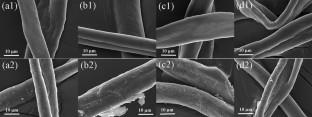Cellulose ( IF 4.9 ) Pub Date : 2022-06-16 , DOI: 10.1007/s10570-022-04663-x Wenjun Li , Hui Zhang , Yueyue Song , Wenming Li , Wenduo Chen , Hailiang Wu

|
The amount of photocatalysts loaded on the supporting materials and their bonding configuration by physical or chemical mode have great effects on the photocatalytic properties and stabilities of the photocatalytic composites in practical application. However, to our knowledge, the influence of the crystal structure of support material on the photocatalytic performance of the resultant photocatalysts has never been studied till now. Herein, four polymorphic cotton fibers (cellulose Iβ, II, IIII and IVI) were utilized as the support to load anatase TiO2 nanoparticles by a hydrothermal method. The structural changes of cotton fibers before and after loading TiO2 were characterized by scanning electron microscopy, transmission electron microscopy, X-ray diffraction, thermal gravimetric analysis, X-ray photoelectron, diffuse reflectance and photoluminescence spectroscopies. Their photocatalytic properties were examined towards the photodegradation of the model Congo red (CR) dye under visible light illumination. Results indicate that the crystalline structure of cotton cellulose affects the loading dosage of anatase TiO2 nanoparticles on cotton fibers and the doping ratio of C, N and O elements in TiO2, which results in the differences of the degradation rates of CR dye over the TiO2 modified cotton fibers. Because the TiO2 hydrothermal modification makes the crystallinity and orientation degree of cotton cellulose II decrease, the cotton cellulose II fibers might load more TiO2 nanoparticles than the other three cotton cellulose fibers via the bonds of C-Ti3+/Ti4+, N-Ti3+/Ti4+ and O-Ti3+/O-Ti4+. This leads to a narrowed band-gap of the resultant composites which exhibit a high photocatalytic activity for the photodegradation of CR dye. The density functional theory calculations demonstrate that the different crystalline structures of cotton cellulose I, II, and IVI affect the densities of state of C, N and O co-doped TiO2, thus resulting in various band-gaps.
Graphical abstract
中文翻译:

棉纤维素晶体结构对纳米TiO2固定棉纤维光催化活性的影响
负载在载体材料上的光催化剂的量及其物理或化学方式的键合构型对实际应用中光催化复合材料的光催化性能和稳定性有很大影响。然而,据我们所知,迄今为止,载体材料的晶体结构对所得光催化剂的光催化性能的影响还没有被研究过。在此,四种多晶型棉纤维(纤维素I β、II、III I和IV I)被用作通过水热法负载锐钛矿TiO 2纳米颗粒的载体。负载TiO 2前后棉纤维结构变化通过扫描电子显微镜、透射电子显微镜、X射线衍射、热重分析、X射线光电子、漫反射和光致发光光谱对其进行了表征。研究了它们的光催化性能,以在可见光照射下对模型刚果红 (CR) 染料进行光降解。结果表明,棉纤维素的晶体结构影响了锐钛矿型TiO 2纳米粒子在棉纤维上的负载量以及C、N、O元素在TiO 2中的掺杂比例,从而导致CR染料的降解速率与纤维的不同。 TiO 2改性棉纤维。因为 TiO 2水热改性使棉纤维素Ⅱ的结晶度和取向度降低,棉纤维素Ⅱ纤维可能通过C-Ti 3+ /Ti 4+、N-Ti 3键负载比其他三种棉纤维素纤维更多的TiO 2纳米颗粒+ /Ti 4+和 O-Ti 3+ /O-Ti 4+。这导致所得复合材料的带隙变窄,其对 CR 染料的光降解表现出高光催化活性。密度泛函理论计算表明,棉纤维素I、II和IV I的不同晶体结构影响C、N和O共掺杂TiO 2的态密度,从而导致各种带隙。











































 京公网安备 11010802027423号
京公网安备 11010802027423号